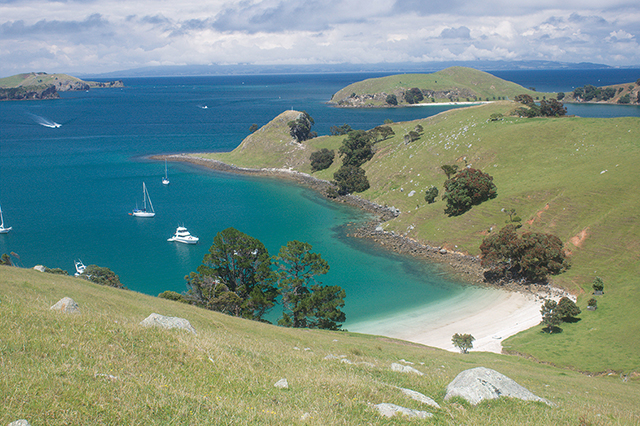A practical guide to cruising by land and water, with tips on where to get those boat projects done, too (published August 2014)
For many trans-Pacific sailors, New Zealand is the “Promised Land”: a safe, English-speaking place south of the cyclone belt. It’s a place for sailors to slow down, relax, and catch up with boat projects—after all, most will have come all the way from the Americas in one long, 6,000 mile season. But six months can feel like a long time to spend in one place, especially for the cruiser accustomed to a harried pace. Where to go? How to divide your time? This article outlines the options for a season in New Zealand to help you better plan your stay.
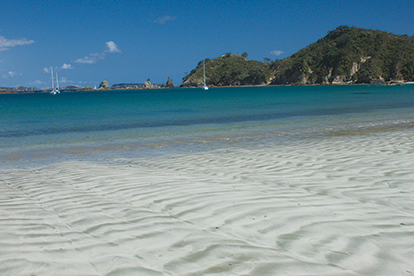
Most inbound yachts choose Opua in the Bay of Islands as their port of entry; others head straight for Auckland or Marsden Cove (Whangarei). New Zealand requires an advance notice of arrival for private yachts, which is a simple matter of downloading and submitting an online form (http://www.customs.govt.nz). The form must be filed at least 48 hours before arrival, but you can send it in weeks earlier and update your arrival date by email. Upon clearing in, most passport holders are granted a free three-month visa, which can be extended for up to nine months by mail (NZ$165 per family). Once such business is taken care of, the travel-weary fleet slowly dissipates to sample their pick of the myriad choices on water or land.
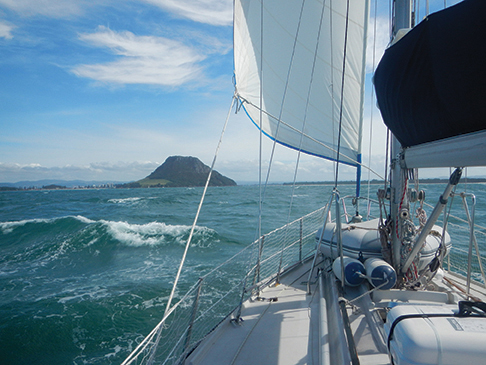
CRUISING GROUNDS: The Bay of Islands
After months devoted to long blue water passages, sailors delight in New Zealand’s rich cruising grounds, starting with the Bay of Islands. There, a smattering of uninhabited islands offer anchorages for every wind direction, not to mention pristine beaches, hiking trails and a hurricane hole or two. You’ll awake each day to emerald views and exotic birdcalls, like the wavering, gong-like call of the tui.
Our favorite islands were Urupukapuka for its varied hiking and undulating terrain and Moturua for its dramatic scenery and forested slopes. Whenever a northerly gale piped up, we’d drop anchor in muddy Orokawa Bay. And when the weather settled again, we could set a course for Roberton Island, a thin strip of land nearly trisected by tidal lagoons. Most dangers to navigation are marked and the tidal range is a mere five feet. For us, the area summons memories of swimming, hiking and dolphin spotting—an idyllic place and time.
Still, the Bay of Islands is much smaller than its reputation suggests. Although there are dozens of lovely anchorages, the prime destinations boil down to a handful of islands and mainland bays, none of which are more than fifteen miles from each other. Two weeks is plenty of time for a laid-back circuit of the bay. More is better, but many sailors get itchy feet once they exceed the six-week mark. That’s when it’s time to check the continuous VHF weather forecast and head farther afield. We quickly learned to take weather forecasts with an extra grain of salt: with no landmass to buffer the island nation from the Antarctic, weather is notoriously unpredictable. On the other hand, we found the cruising information in David Thatcher’s excellent cruising guides (New Zealand’s Hauraki Gulf and New Zealand’s Northland Coast, each including a section on weather) spot-on throughout our stay in New Zealand.
BEYOND THE BAY OF ISLANDS
Two enticing destinations beckon just a day sail north of the Bay of Islands: the Cavalli Islands and Whangaroa, a perfectly sheltered, fjord-like bay. We spent a happy two weeks there, sometimes the sole boat in one of the many anchorages. The sail north can be exhilarating, with the feel of the open ocean even on this short coastal hop. Still, it’s all line of sight navigation—a real treat after months of blearily eying the compass. Great Cavalli Island is essentially a taller, larger cousin of the places we’d become familiar with in the Bay of Islands, with wooded trails and views of a fractured seascape. Apparently, a day off the beaten track is a day too many for most. Here, you can safely divide the number of visitors by 10 and multiply the length of the beaches by two.
At some point, almost every visiting sailor heads south to Auckland and the Hauraki Gulf. Doing so requires a mental shift from “paradise at anchor” to full sailing mode for the trip along the raw, exposed coastline. On a bad day, this coast can conjure up images of the wild Southern Ocean. At its best, conditions will be just right for two to three days of enjoyable day sailing to the Hauraki Gulf. We quickly learned to follow local cruisers well offshore to avoid confused inshore wave action and to elude unmarked hazards like the appropriately named Wide Berth Islands and Danger Rock.
The most interesting stop between the Bay of Islands and the Hauraki Gulf is Whangamumu, just around the corner from Cape Brett. It’s a large, circular bay open to the east, uninhabited but for the ruins of an interesting whaling station. A number of hiking paths branch out from here. Other anchorages along the way include Tutukaka and the outer reaches of Whangarei. While several islands cluster along this stretch of coast, most are nature reserves where you can‘t step ashore; you’ll also be hard pressed to find a safe anchorage among them.
THE HAURAKI GULF
Right at the doorstep of Auckland, the Hauraki Gulf is the undisputed queen of New Zealand’s cruising grounds. Take your pick and sample city life or escape to wooded reserves like Tiritiri Matangi Island. Thanks to steady ocean breezes and relatively calm waters, the sailing is outstanding. We took to heading wherever the wind blew us, setting our Parasailor for the sheer joy of a brisk downwind run or working upwind among a fleet of pleasure sailors. Every island in the gulf is unique and distances are generally short. You might hike the ashy slopes to the volcanic peak of Rangitoto one morning, then sail away on a 15 knot southeasterly to end the day off one of Waiheke Island’s posh neighborhoods. Of course, you’ll be sharing this playground with a “city of sails,” but most of the anchorages are spacious.
One of the best places to get away from it all within a day of Auckland is peaceful Te Kouma Bay on the rugged Coromandel Peninsula. Literally capping the gulf is Great Barrier Island, where you can hike among native kauri trees and visit Smokehouse Bay, where a do-it-yourself woodfire hot tub awaits. Given all there is to see and do afoot and afloat in the greater Auckland area, even the most burned-out Pacific cruiser can spend months here.
SOUTH TO TAURANGA
Cape Colville, the northeastern-most point of the Hauraki Gulf, marks the outer limit of many sailors’ self-imposed cruising grounds, leaving all the more room for the rest of us. Great Mercury Island, just one day farther southeast, is an absolute stunner with its long, sandy beach and beautiful scenery. Depending on the weather, there are several anchorages where you can break up a trip south, including Mercury Bay, Mayor Island and Slipper Island.
Tauranga and its sister city, Mount Maunganui, are pleasant places that attracted us for several reasons. From there, we could rent a car to reach the best-known inland attractions of the North Island: Rotorua, for its culture and thermal activity; Lake Taupo, for beautiful scenery; and Tongariro National Park, for its lunar landscape. With some of the lowest marina and yard fees on the North Island, Tauranga is also a good place for boat work (see below). Truly hardy sailors press on to the South Island’s spectacular Fiordland, but the more extreme weather of the south confines most sailors to the north/central part of the North Island, particularly since land travel to the South Island is so easy (see below). Of course, that only multiplies the rewards for those who do sail south.
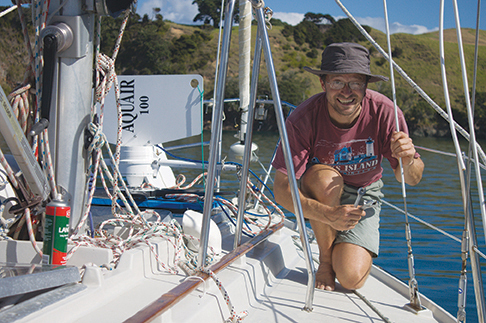
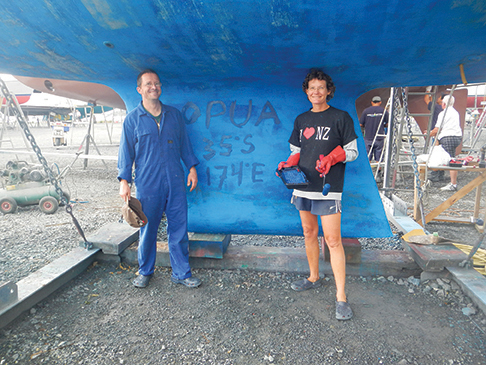
HAUL OUTS AND YARD TIME
After thousands of miles of ocean wear, most boats will be begging for maintenance, repairs or improvements. A good time to schedule work might be during New Zealand school holidays from late December to early February, when it seems that two out of three million Kiwis hit the water. It’s a nation of boaters, and it shows.
Whangarei offers the widest choice of services and boat yards on the North Island. It’s also a good place to store a boat safely in the owner’s absence. The disadvantage of basing boat work out of Whangarei is that there are no attractive options for local sailing; you’ll truly be upriver. Still, Whangarei earned top marks from every sailor we know who visited, both for price and quality of services. The excellent Whangarei Marine Promotions guide is available online and in yachtie hangouts as far back as Tahiti and Tonga. Check out Town Dock, Marsden Cove Marina and Docklands 5, Riverside Drive, or Norsand yards.
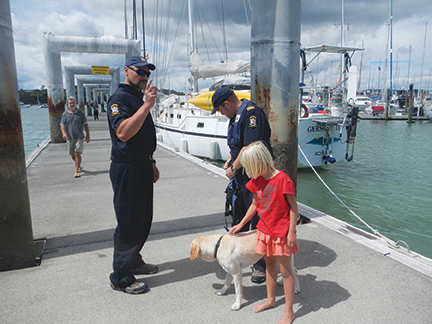
Opua is another good base for boat work, with a couple of good chandlers and yards; prices are typically a hair above Whangarei’s (try Opua/ Northland Marina and Ashby Boatyard). The advantage of working out of Opua is the proximity to beautiful cruising. We spent the final month of our stay whittling down our job list there. After applying a fresh coat of antifouling, we picked up parts and groceries and headed out to the islands to do our work in idyllic surroundings. With only a one to two hour commute back to town for more supplies, this is also conducive to saving money, as you can’t spend a cent once you’re out in the bay.
Greater Auckland is yet another possibility for boat work or an extended stay, though prices are a tick higher than elsewhere. The advantage of working out of Auckland is the stimulating city and fine Hauraki Gulf cruising grounds (popular choices are Westhaven and Bayswater Marinas, or Gulf Harbour Marina farther afield).
We were drawn to Tauranga by low marina rates and settled in for a month of intense boat work in a place brimming with chandlers, hardware stores and electrical supply shops (see Tauranga Bridge Marina or Tauranga Marina). There’s not much local cruising there, but we broke work up with hikes up Mount Maunganui and an inland trip.
Budget on roughly NZ$25 per night in a marina for a 35-foot boat in any of these locations; rates drop for week/month-long stays. Word is that rates are even cheaper down in Napier (farther south along the North Island’s east coast), but the trip around several wind-swept capes keeps many away.
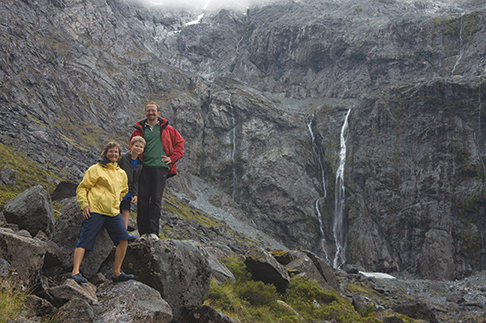
LAND-BASED TRAVEL
With so much to see and do in “Middle Earth,” it’s no wonder that many sailors opt for a period of extended land travel. Used car deals abound in Opua, Whangarei and Auckland, including convenient buy-back packages. These deals usually entail a NZ$2,000 difference between the buying and selling price, with everything from compact cars to camper vans available. The early bird gets the best pickings; so if you’re serious about buying a car, shop as soon as you arrive in New Zealand.
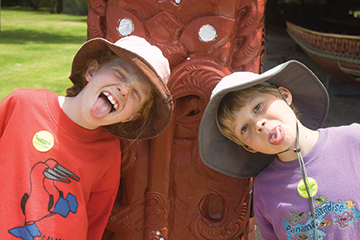 We opted to cruise for most of our stay with short periods of land travel. Jucy Car Rental‘s “El Cheapo” was our vehicle of choice and despite the name, it never, ever let us down. Jucy also has some of the best deals on campers, as well as last minute delivery deals. For a shorter trip to the South Island, consider flying with Jet Star. We paid NZ$150 per round trip ticket from Auckland to Queenstown and spent a grand total of NZ$2,100 for three people in 10 days (including flights, car, self-catering stays in backpacker lodgings and modest sightseeing). The local tourism industry specializes in the bold and exhilarating: bungee jumping! White water rafting! Lord of the Rings trail rides! The catch? These activities cost upwards of NZ$150 per person. We stuck to hiking, splurging only for a Milford Sound cruise and a day’s mountain bike rental. We were pleased as punch with our mini trip/local cruising combination, while other sailors were delighted with the months they spent traveling overland. The moral of the story is, there’s something for every budget in this beautiful island nation.
We opted to cruise for most of our stay with short periods of land travel. Jucy Car Rental‘s “El Cheapo” was our vehicle of choice and despite the name, it never, ever let us down. Jucy also has some of the best deals on campers, as well as last minute delivery deals. For a shorter trip to the South Island, consider flying with Jet Star. We paid NZ$150 per round trip ticket from Auckland to Queenstown and spent a grand total of NZ$2,100 for three people in 10 days (including flights, car, self-catering stays in backpacker lodgings and modest sightseeing). The local tourism industry specializes in the bold and exhilarating: bungee jumping! White water rafting! Lord of the Rings trail rides! The catch? These activities cost upwards of NZ$150 per person. We stuck to hiking, splurging only for a Milford Sound cruise and a day’s mountain bike rental. We were pleased as punch with our mini trip/local cruising combination, while other sailors were delighted with the months they spent traveling overland. The moral of the story is, there’s something for every budget in this beautiful island nation.
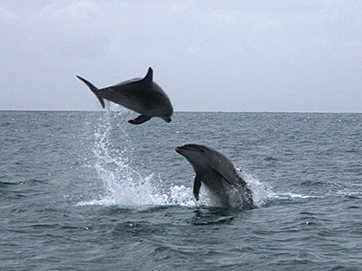
OTHER PRACTICALITIES
The first thing we did upon arriving in Opua was to open a free checking account with the local branch of Kiwi Bank in Paihia. Although we paid a fee for transferring money from our home account, we ultimately saved by having a local credit/debit card. Another early order of business was communications. Vodafone is the biggest 3G cellular provider, and their dongle can be reused in Fiji with a local SIM card. Internet coverage is good if not speedy; we hiked many a hill in the Bay of Islands to pick up a signal where coverage down in the anchorage was poor.
After the relaxed standards of Polynesia, Kiwi officials can seem positively draconian in some of their regulations. Only locally certified gas cylinders will be filled with propane, for example, and only locally certified power cords can be used for shore power. And although New Zealand is an extremely friendly host nation in all respects, crews who overstay their visas are subject to heavy fines. This became an issue when ugly fall weather delayed many a boat’s departure for the tropics, exactly as crews butted up against their visa expiration dates. Officials run regular patrols of island anchorages, so don’t even think about laying low anywhere but the crowded anchorage of Opua. That said, customs officials in Opua didn’t pressure anyone to leave in the face of bad weather; present your case in person to explore options for a short-term extension.
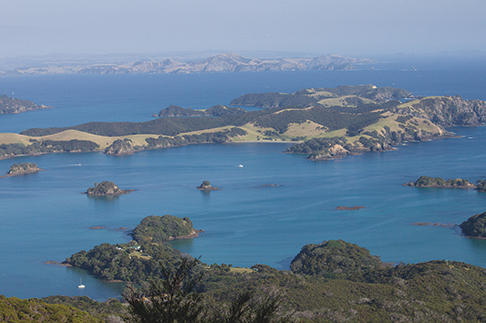
New Zealand might not have it all, but it comes pretty darn close. Sailing for every ambition level and a variety of attractions on and off the water made our six months whiz by. At the end of a full season in New Zealand, most cruisers will have regenerated enough to look forward to new destinations in “the Islands”—the generic Kiwi term for Tonga, Fiji, Vanuatu and New Caledonia. Some like this part of the world so much that they bounce between New Zealand and the tropics for season after season, cultivating friendships in both places and revisiting favorite spots. Alas, we don’t all get to sail on that kind of schedule, but even one season is enough to create a treasure trove of memories.
Nadine Slavinski is the author of Lesson Plans Ahoy: Hands-On Learning for Sailing Children and Home Schooling Sailors. Together with her husband and young son, she cruised the Atlantic and Pacific aboard her 1981 Dufour 35, Namani. She is currently at work on The Silver Spider, a novel of sailing and suspense, as well as Pacific Crossing Notes: A Sailor’s Guide to the Coconut Milk Run (see nslavinski.com for more information and free resources on home schooling).















